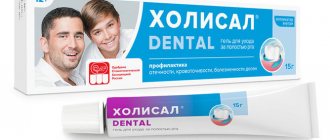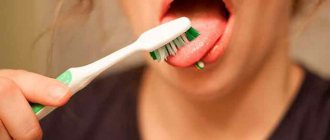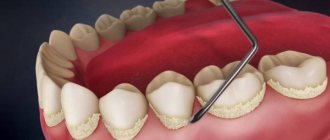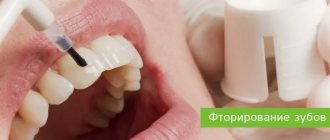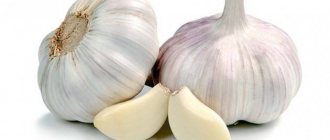Medicinal herbs and decoctions will help to completely get rid of a mild form of the disease, as well as at the very beginning of the development of the disease.
It is necessary to remember: herbal decoctions and infusions are also medicine; they should be used only after consultation with a doctor.
There are forms of the disease that cannot be treated without antibiotics and other medications. Therefore, folk methods and recipes for the treatment of stomatitis are of an auxiliary nature.
Causes of stomatitis in adults
Each of us has encountered stomatitis at least once.
This disease occurs with equal frequency in children and adults, but at an early age, due to rapid tissue regeneration, it goes away much faster. Stomatitis is an inflammatory disease of the oral mucosa; it is easily identified by the appearance of itchy ulcers or erosions (there can be several of them of different sizes) on the inner surface of the cheek, tongue or gums. “The causes of stomatitis can be very different,” says dentist-therapist Rezeda Nigmatullina . “It could be failure to comply with personal hygiene rules, the use of a low-quality toothbrush with too hard bristles, which scratches the mucous membrane, and excessive indulgence in salty, spicy and sour foods.” , and poorly fitting dentures, braces and crowns, and a passion for mouth rinses that can disrupt the natural microflora. If you often bite your lip or the inside of your cheeks, you also run the risk of developing stomatitis.
Stomatitis in adults can be a symptom of any disease or inflammatory process developing in the body. Stomatitis can occur with vitamin deficiency or a weakened immune system, with severe stress and after taking antibiotics, with anemia and diabetes, and even with helminth infection! In approximately 70% of cases, stomatitis in adults occurs after tooth extraction, when the microflora in the mouth is disturbed, and antibiotics are imposed on top. If you do not maintain careful oral hygiene, plaque can turn into tartar, which causes not only stomatitis, but also periodontal disease and periodontitis.
Herbal infusions
In modern herbal medicine, both herbal decoctions (chamomile, sage, yarrow, oak bark) and tinctures (calendula, propolis) are used to successfully treat oral diseases. Traditional methods of treating stomatitis allow you to:
- relieve inflammation of the mucous membrane;
- reduce pain and swelling;
- relieve itching, reduce burning sensation;
- cure ulcers (aphthae) formed on the surface of the mucous membrane;
- improve the patient’s overall well-being;
- prevent relapses of the disease.
Chamomile, aloe, sage, oak bark for stomatitis can significantly reduce swelling and soreness of the mucous membrane, and prevent the development of the inflammatory process. They have an anti-inflammatory effect.
Herbal infusions can be used either alone or in combination with traditional medicines.
- Decoctions . To prepare them, you need to grind the herb in a coffee grinder, pour boiling water over it in a certain proportion, boil for at least 10 minutes, and then leave to infuse. A decoction is prepared from one plant (for example, chamomile, calendula, sage, St. John's wort) or from several (herbal mixture). After infusion, it should be strained and stored in the refrigerator for no more than three days. In the treatment of oral diseases, decoctions of chamomile, yarrow, sage, calendula, and cinquefoil are most often used. It should be remembered that when treating stomatitis with herbs, the therapeutic effect does not occur immediately, but 1-3 weeks after the start of therapy. Therefore, the patient must tune in to a long-term regular process.
- Infusions . They are prepared in much the same way, only they should not be boiled. Usually the herbal mixture is poured with boiling water, tightly closed and infused, after which it is filtered. It should be stored in the refrigerator and diluted with water before use. Infusions are prepared from the same herbs as decoctions. You can infuse herbs not with water, but with alcohol. They have a powerful antiseptic and anti-inflammatory effect.
- Solutions . Medicinal solutions are prepared immediately before use; their preparation consists of diluting the finished product with boiled water to obtain the required consistency. In no case should you apply undiluted alcohol infusions to the surface affected by stomatitis, as there is a high probability of getting a burn to the mucous membrane.
Symptoms of stomatitis in adults
As a rule, stomatitis in adults does not cause severe discomfort at first. A person may feel a burning or swelling in the mouth, followed by an itchy sore that hurts and becomes irritated when brushing teeth and chewing solid food. The sore may be bright red or covered with a thin white or grayish film, usually round or oval in shape, with smooth edges. If treatment is not started, a person may develop bad breath or gums that bleed. In particularly advanced cases, a person may complain of severe pain even when taking a sip of water.
“If you start inflammation, complications can begin.” The patient may have a fever, sleep disturbances, cannot eat normally and becomes irritable, says the dentist.
Diagnostics
The diagnosis of “allergic stomatitis” is made by a dentist based on an examination of the oral cavity and questioning the patient about underlying diseases and medication use. The dentist clarifies the clinical picture of the disease.
The doctor must conduct a comprehensive examination and diagnosis:
- removable and fixed prostheses;
- braces;
- filling
To clarify the clinical picture of the disease, the specialist refers the patient for a comprehensive blood and urine test and an immunogram to assess the state of the immune system. If necessary, the doctor sends the patient for the following studies:
- determination of the acidity level and composition of saliva;
- identification of the activity of enzymes contained in saliva;
- leukopenic test;
- provocative tests with removal and subsequent installation of prostheses.
An integrated approach to diagnosing allergic stomatitis will allow you to quickly find out the cause of the negative reaction, eliminate it and begin effective treatment.
Types of stomatitis in adults
According to the degree of progression and nature of damage to the mucous membrane, stomatitis in adults is divided into catarrhal, aphthous and ulcerative forms.
The catarrhal (superficial) form of stomatitis is considered the mildest - it does not cause serious discomfort, does not affect the deep mucous membrane and goes away quickly with treatment. With catarrhal stomatitis, ulcers do not occur, the mucous membrane swells and becomes red, and a white coating appears on the tongue. Salivation increases and bad breath may appear.
“The causes of catarrhal stomatitis are most often poor oral hygiene, the presence of caries or dental plaque and tartar, an overly aggressive composition of toothpaste or mouthwash, and indulging in very hot or cold drinks and food,” says the dentist-therapist.
Aphthous stomatitis begins with a small transparent vesicle, which quickly bursts and forms aphthae - small erosions of a whitish or grayish color, covered with a thin film and with a red border at the edges.
“Often aphthous stomatitis in adults becomes chronic and manifests itself in relapses in the spring and autumn, when immunity falls and the body is weakened,” explains Rezeda Nigmatullina.
Ulcerative stomatitis is the most severe form, because in advanced cases it can cause tissue death (necrosis). Most often it affects the gums, which become covered with a grayish coating with an unpleasant odor. If it is removed, the area begins to bleed. A person may have a fever, swollen cervical lymph nodes, and pain in the mouth becomes so severe that he even refuses to eat. Once healed, ulcers may leave deep scars.
Good to know
Inflammation and bleeding gums: how to deal with them
Due to the occurrence of stomatitis, they are divided into:
Mechanical (traumatic) stomatitis - when you bite the mucous membrane, it is injured by a sharp chipped edge of the tooth, a poorly fitted crown or braces, or an incorrectly selected toothbrush. If the inflammation is not accompanied by an infection, then when the cause is eliminated, it quickly and completely disappears.
Herpetic stomatitis in adults is quite common, since many people are carriers of the herpes virus. With a healthy immune system, it does not manifest itself in any way, but with a weakened immune system, prolonged hypothermia, severe stress, or an exacerbation of any chronic disease, it can manifest itself in the form of stomatitis. Herpetic stomatitis in adults appears in the form of multiple blisters on the mucous membrane of the lip, which burst, forming an itchy erosive area.
Candidal stomatitis in adults occurs with a very weakened immune system, because fungi of the genus Candida live in the body of every person, but manifest themselves with a general weakening of the body or long-term use of antibiotics, less often - after close contact with another patient. It is easy to recognize candidal stomatitis - it manifests itself in the form of a whitish, cheesy coating on the oral mucosa.
Bacterial stomatitis in adults is caused by staphylococci, streptococci and gonococci, which affect the oral cavity and nasopharynx. Stomatitis, as a rule, is a concomitant disease with sore throat, sinusitis, otitis media and other diseases.
Allergic stomatitis can appear as a reaction to certain medications or to external allergens. The patient complains of hyperemia of the oral mucosa, rash and itching; ulcers appear much less frequently. When the cause (allergen) is eliminated, stomatitis goes away within a couple of days.
Causes of the disease
As is clear from the name of the disease, a negative reaction of the body develops after contact with various allergens. Most often, allergic stomatitis occurs after contact with plant pollen or mold spores. The disease can also manifest itself against the background of:
- installation of crowns, fillings, prostheses made of low-quality materials;
- consumption of certain types of food (especially in children);
- decreased immunity;
- course of treatment with antibacterial drugs or sulfonamides;
- advanced caries;
- bleeding gums;
- inflammation of the oral cavity;
- proliferation of pathogenic microorganisms in the oral cavity.
Sometimes allergic stomatitis manifests itself as a complication of Lyme disease, systemic lupus erythematosus, aphthous stomatitis, hemorrhagic diathesis, and Stevens-Johnson syndrome.
Treatment of stomatitis in adults
Medicines
Treatment of stomatitis in adults is carried out with local antiseptics, agents to accelerate tissue regeneration, and if necessary, the doctor may prescribe antibiotics or antiviral drugs.
— Complex preparations with analgesic, anti-inflammatory and healing properties have proven themselves well: for example, Cholisal or Kamistad gels. They are prescribed for a variety of types of stomatitis and very quickly reduce redness and swelling of tissues, remove pain, and prevent secondary infections. It is enough to smear the affected areas with a thin layer 2-3 times a day for 10 days, advises the dentist. – Antiseptic sprays such as Ingalipt or Chlorophyllipt, which contain an extract of eucalyptus leaves, a powerful natural anesthetic and antiseptic, help to quickly remove unpleasant symptoms. The mouth should be irrigated at least 3-5 times a day for 7-10 days.
Folk remedies
In addition to medications, unpleasant symptoms of stomatitis in adults can be successfully treated using folk remedies. For example, to remove swelling and redness, you can rinse your mouth with an infusion of chamomile or calendula. Rinse should be done 2-3 times a day and continue for a week until symptoms disappear completely.
Rinsing with soda and salt helps relieve inflammation (a teaspoon of soda and salt per liter of warm boiled water, 200 ml of solution is enough for one rinse). Aloe juice helps relieve pain and inflammation and speed up healing - they need to treat the affected area 2-3 times a day for about a week. Sea buckthorn oil, which can be purchased at any pharmacy, also has good healing properties. Use it to apply compresses to the affected area or simply treat the lesions with a cotton swab several times a day.
“If the symptoms of stomatitis do not go away within 10 days or the patient’s condition worsens, you should immediately consult a doctor to avoid serious consequences,” advises Rezeda Nigmatullina. – It is not recommended to cauterize stomatitis with brilliant green, iodine or alcohol, as you can cause a burn to the mucous membrane.
On a note
How stomatitis is treated in children, we discuss with doctors
Treatment with honey and propolis
Propolis has unique antibacterial and anti-inflammatory properties. An alcohol tincture of propolis for stomatitis allows you to get rid of the resulting aphthae. The drug not only disinfects, but also anesthetizes the inflamed surface.
It is necessary to dissolve a teaspoon of the medicine in a glass of warm water, rinse the mouth with the resulting solution or use it for applications and lubrication of ulcers. It is advisable to first disinfect the affected area with hydrogen peroxide, and then apply propolis.
The medicine is used for:
- rinsing;
- applications;
- wiping.
It is strictly forbidden to apply alcohol tincture directly to canker sores!
Honey has powerful antiseptic properties and is included in many proven folk remedies. However, among doctors there is no clear answer to the question of how to treat and whether stomatitis can be treated with honey. It is believed that it can promote the proliferation of pathogenic bacteria.
Honey is most often used to treat diseases in children.
One of the most popular recipes is the egg-honey mixture. To prepare it you need to take:
- one egg (white);
- a teaspoon of honey;
- 1 ampoule of novocaine;
- one ampoule of vitamin B1 and B6.
Beat the resulting mixture well, take 1 tablespoon orally before meals, keep this portion in your mouth until completely absorbed.
Prevention of stomatitis in adults
Prevention of stomatitis in adults is quite simple: you need to adhere to a healthy lifestyle, limit the consumption of sour, spicy, smoked foods, give up bad habits, and avoid too hot or ice-cold drinks and dishes. To avoid oral injuries and keep your teeth intact, it is better not to chew nuts and candies. If a tooth breaks and the sharp ends scratch your cheek, you should immediately consult a dentist.
— In general, regular visits to the dentist are already the prevention of stomatitis. If caries is treated in time and tartar is removed, there will be fewer pathogenic microbes in the mouth that cause inflammation. Do not forget to change your toothbrush every three months, do not get carried away with antibacterial toothpastes and rinses, so as not to disturb the microflora. And, of course, take care of your health and immunity,” advises the dentist.



